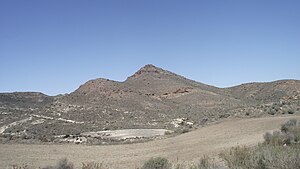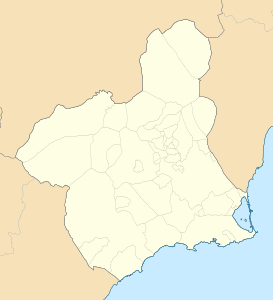Barqueros volcano
| Cabezo del Morrón | ||
|---|---|---|
|
The Barqueros volcano with the Cabezo del Morrón |
||
| height | 398 msnm | |
| location | Murcia Province , Spain | |
| Coordinates | 37 ° 57 '20 " N , 1 ° 21' 45" W | |
|
|
||
| rock | Lamproit ( Fortunit ) | |
| Age of the rock | 6.96 million years BP ( Messinian ) | |
The Barqueros volcano , north of Barqueros in the Spanish province of Murcia , is the largest volcano in the Murcia region in terms of area . Its lamproite rock ( fortunite ) belongs to the southeast Iberian volcanic province . It originated around 7 million years ago BP in the Messinian .
description
The volcanic building of the Barqueros volcano, which covers around 3 square kilometers, has an oval floor plan. Its 3-kilometer main axis is oriented to the northeast / southwest, its transverse axis is about 1 kilometer in a northwest-southeast direction. The volcano culminates in the 398 meter high Cabezo del Morrón , which towers above its surroundings by 80 meters.
The volcano has a central tuff ring with a diameter of 800 meters, the center of which is located in a depression about 300 meters southwest of the Cabezo del Morrón . The tuff ring is covered by a lava flow that takes up the entire volcanic structure . In the final phase, a welding slag cone with a radius of 250 meters built up over the lava flow , which now forms the summit of the Cabezo del Morrón .
Phreatomagmatic tuff ring stage
Ascending lamproite magma had penetrated into still unconsolidated Miocene sediments of the marine shallow water area (beach area?). Contact with groundwater resulted in phreatomagmatic explosions that blasted a crater free and gradually created a tuff ring. The tuff ring is constructed symmetrically radially outwardly incident layering with - to recognize radially outwardly arranged flow direction indicator in surge deposits (and asymmetric Impakteinsackungen . Engl impact sags ). In the south, the tuff ring is made up of a 7-meter-thick, long-wave undulating sequence of fine-grained lapillite tuffs and tuffs, which merge into the hanging wall in indistinct to well-layered tuffs with accretionary lapilli of up to 4 millimeters in diameter. In the hanging wall of the south-east there is a clearly layered, 20-25 centimeter-thick series of massive, well-sorted lapillite tuffs containing juvenile bombs with their bagging structures. The hanging wall on the western edge of the tuff ring also consists of well-layered, fine-grained tuffs. They show slightly corrugated storage conditions with differential compaction (English pinch-and-swell ) as well as occasional oblique stratification from varying proportions of host rock clasts such as rounded quartz or limestone rocks.
Effusive stage
The southern part of the tuff ring is covered by a 3 to 4 meter thick lava outlet, whereby the original conical shape of the ring was preserved. These lavas of constant thickness can also be found in the other sectors of the ring structure. It must have been a fissure eruption, since a straight conveying duct running tangentially to the crater rim could be detected on the east side. The lavas and corridors consist of low-crystal lamproit with clearly recognizable flow bands and therefore low viscosity .
Welding slag cone
After the effusive stage, an asymmetrical weld cinder cone built up on the northern edge of the tuff ring (with a steeper side towards the tuff ring center), which released lava from its base to the northeast and also to the west. The cone measures around 500 meters in diameter and is around 80 meters high. Its deposits consist of heavily oxidized, agglutinated bombs and lapilli. The juvenile components are quite void of bubbles and can be rounded or flattened. Since large pyroclasts cool down more slowly, they could be plastically deformed when they landed, whereas smaller lapilli still solidified in the air.
interpretation
The initial hydromagmatic stage was probably made possible by the existence of a leaky aquifer in the Miocene sediments. The low-concentration pyroclastic density currents and wet surge deposits resulting from the contact with the abundant magma supply indicate a rather shallow source of the explosions. After the groundwater supply had dried up, conveyor tunnels broke through the southern and northern parts of the symmetrically heaped tuff ring and sent lavas over the flanks. The extraction activity finally concentrated on the northern edge of the ring and built the typical Hawaiian cinder cone of the Cabezo del Morrón , which emerged from lava fountains , from which lava again mainly flowed to the northeast, but also partially flooded the crater of the tuff ring.
mineralogy
The petrographic structure of the lava flow is mainly aphanitic to moderately porphyritic. Olivine and phlogopite act as phenocrystals . The basic mass is glassy , but there are still different degrees of crystallinity with microcrystals of sanidine , diopside , Richterite , relatively rare orthopyroxene as well as accessory apatite and spinel .
Chemical composition
Main and trace elements
| Oxide wt.% |
Fortunit Barqueros |
Trace elements ppm |
Fortunit Barqueros |
|---|---|---|---|
| SiO 2 | 55.32 | Cr | 583 |
| TiO 2 | 1.63 | Ni | 479 |
| Al 2 O 3 | 11.24 | Pb | 113 |
| Fe 2 O 3 | 2.25 | Rb | 500 |
| FeO | 3.40 | Sr | 516 |
| MnO | 0.07 | Zr | 678 |
| MgO | 9.48 | Ba | 1274 |
| CaO | 3.59 | Ce | 248 |
| Na 2 O | 1.25 | Nd | 163 |
| K 2 O | 6.88 | Sm | 26.6 |
| P 2 O 5 | 0.72 | Hf | 19.8 |
| LOI | 4.46 | Th | 106 |
| K / Na | 3.61 | ||
| K / Al | 0.66 | ||
| (K + Na) / Al | 0.85 |
Source: Benito, R. and colleagues (1999)
The fortunite of the Barqueros volcano is an intermediate rock that is oversaturated with silicon . He is also metaluminos with (Na + K) / Al <1 and ultrapotassic (with K / Na> 3). It is one of the alkaline rocks with a predominance of potassium. The main elements CaO and Na 2 O are rather low in concentration .
In the trace elements, the incompatible elements are enriched, LILE , HFSE and rare earths all have high levels. Rubidium , zirconium and thorium in particular are very high . Barium and scandium have relatively low concentrations .
Isotope ratios
The 87 Sr / 86 Sr ratio is 0.718100.
Individual evidence
- ↑ Fúster, JM et al .: Las rocas lamproiticas del SE de España . In: Estudios Geológicos . tape 23 , 1967, p. 35-69 .
- ↑ Seghedi, I. include: Miocene lamproite volcanoes in southeastern Spain - to association of phreatomagmatic and magmatic products . In: Journal of Volcanology and Geothermal Research . tape 159 , 2007, p. 210-224 .
- ↑ White, JDI and Houghton, B .: Surtseyan and related phfeatomagmatic eruptions . In: Sigurdsson, H. et al. (Ed.): Encyclopedia of Volcanoes . Academic Press, San Diego, ISBN 0-12-643140-X , pp. 495-511 .
- ↑ Wolf, JA and Sumner, JM: Lava fountains and their products . In: Sigurdsson, H. (Ed.): Encyclopedia of Volcanoes . Academic Press, San Diego 2000, pp. 321-331 .
- ↑ Fisher, RV and Schmincke, H.-U .: Volcanic sediment transport and deposition . In: Pye, K. (Ed.): Sedimentary Processes . Blackwell, Oxford 1994, pp. 349-386 .
- ↑ son, YK and Chough, SK: depositional processes of the Suwolbong tuff ring, Cheju Iceland, Korea . In: Sedimentology . tape 36 , 1989, pp. 837-855 .
- ↑ Benito, R. et al.: Sr and O constraints on source and crustal contamination in the high-K calc-alkaline and shoshonitic neogene volcanic rocks of SE Spain . In: Lithos . tape 46 , 1999, pp. 773-802 .


